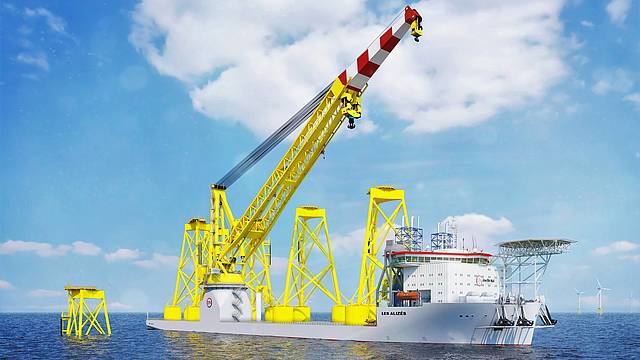
The vessel, to be named "Les Alizés", will be equipped with a full SCHOTTEL propulsion package
In the wake of investment in the "Voltaire" offshore installation vessel, Jan De Nul has now ordered a heavy lift crane vessel capable of lifting 5,000 tonnes from the CMHI Haimen shipyard in China. The vessel, to be named "Les Alizés", will be equipped with a full SCHOTTEL propulsion package. Four rudderpropellers, two retractable rudderpropellers and two transverse thrusters from the German propulsion expert will ensure optimal propulsion efficiency as well as maximum manoeuvrability.
Philippe Hutse, Offshore Director at Jan De Nul Group: "Thanks to her dimensions and her impressive lifting and loading capacities, 'Les Alizés' will be able to load out, transport and install multiple units of the largest and heaviest wind turbine foundations. In addition, as a crane vessel that floats, it will be able to install heavier and larger foundations into deeper waters and in more challenging seabed conditions. To meet these demanding tasks, we are pleased that the reliable propulsion solutions from SCHOTTEL have been selected."
SCHOTTEL thrusters for maximum propulsion efficiency
The main propulsion system of the crane vessel consists of four electrically driven SCHOTTEL Rudderpropellers type SRP 610 FP – each with an input power of 3,000 kW and a propeller diameter of 3.30 m – installed at the stern. With this setup, "Les Alizés" will achieve a maximum speed of 13 knots.
To ensure precise position keeping in DP service, two SCHOTTEL Retractable Rudderpropellers type SRP 610 R (3,250 kW each and a propeller diameter of 3.00 m) and two SCHOTTEL Transverse Thrusters type STT 7 FP (2,600 kW each and a propeller diameter of 2.79 m) are installed in the bow of the vessel. The retractable units are fitted with an 8° downwards-tilted propeller shaft in order to reduce thruster-thruster and thruster-hull interactions and increase propulsion efficiency. The tunnel thrusters are designed so that they can be serviced while the vessel is afloat.
Reduced downtime, reduced lifecycle costs
As part of an extended dry-docking program, "Les Alizés" will be able to prolong its dry-docking period from 5 to 7.5 years. To make this possible, the vessel will be equipped with a state-of-the-art condition monitoring system from SCHOTTEL. It offers automatic, 24/7 on-board surveillance of the propulsion units – even in full offline mode. The permanent vibration monitoring of the system and automatic trend observation of the monitored data allows for thruster maintenance based on their current condition. This helps to avoid unnecessary part exchanges and downtimes.
Greater environmental protection with SCHOTTEL LEACON
The 236.80-metre-long and 52.00-metre-wide crane vessel will be environmentally compliant thanks to the on-board integration of the same advanced emission control technology found on all other low-emission vessels in the Jan De Nul fleet. It will carry a Cleanship NDO7 label and a Green Passport EU label.
At the same time, the thrusters of "Les Alizés" will be equipped with the patented and DNV-GL type-approved SCHOTTEL LEACON sealing system. This system ensures continuous leakage control of the seals and prevents water from entering the gearbox and, of even greater importance, oil from escaping into the seawater. Considered a non-oil-to-water interface, the system complies with the VGP regulations of the US Environmental Protection Agency (EPA) without the need to use environmentally acceptable lubricants (EALs).
Loading, transporting, lifting and installing turbine foundations
"Les Alizés" will mainly be used for the construction of offshore wind farms, but is also suitable for decommissioning offshore oil and gas platforms. The key features include a main crane of 5,000 tonnes, a loading capacity of 61,000 tonnes and a deck space of 9,300 m². With these characteristics, "Les Alizés" can transport heavier foundations, several in one trip, to the offshore installation site.
As a result, it responds to the global trend within the offshore wind energy sector to design and install increasingly larger wind turbines. This new generation of turbines can be more than 270 m high, have blades up to 120 m long, and sit on foundations weighing up to 2,500 tonnes.
The new crane vessel is scheduled to enter operation in 2022.